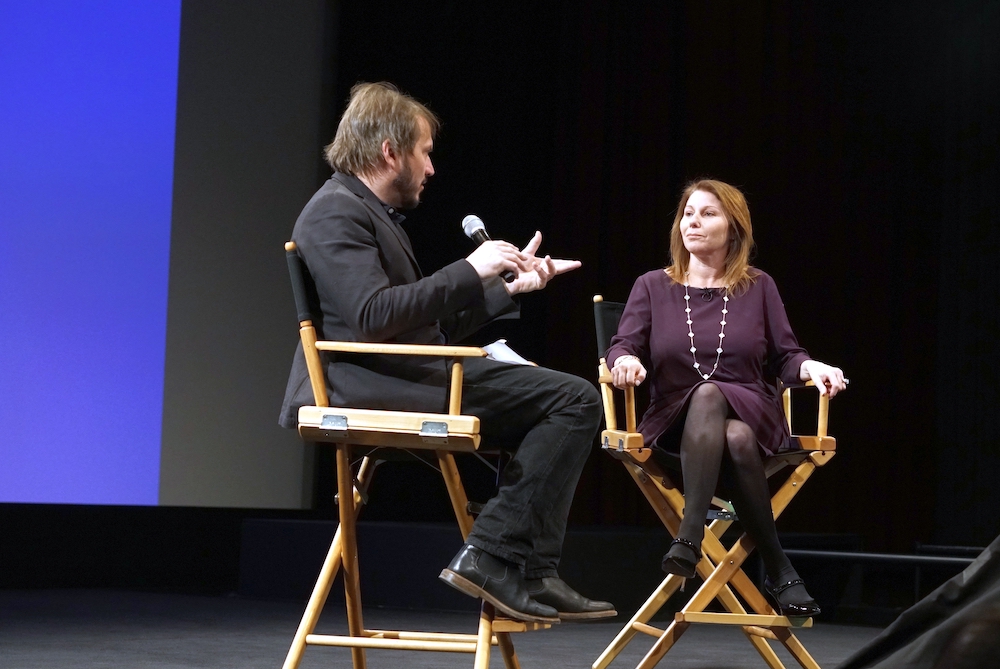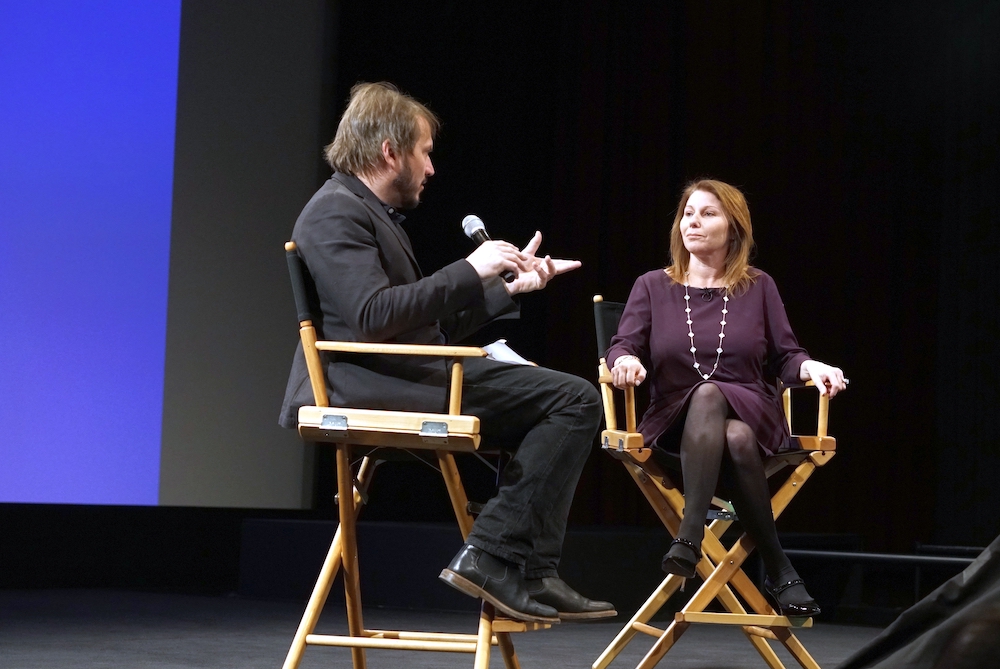In this sponsored interview from PSFK’s Future of Retail 2019 conference, Mastercard’s EVP of North America Marketing & Communications, Cheryl Guerin, explains the value of technology to developing a phygital retail experience, as well as why the brand is dropping the name from its logo to let the symbol speak for itself
Mastercard has evolved its brand to fit within the changing retail landscape. At PSFK’s Future of Retail 2019 conference, founder and CEO Piers Fawkes spoke to Cheryl Guerin, EVP of North America Marketing & Communications, about the next generation of online and offline retail experiences, as well as how Mastercard sees itself within it.
Piers Fawkes: Retail is a such a dynamic space right now. What has Mastercard noticed in terms of consumer and industry trends taking place?
Cheryl Guerin: Everybody should be excited about retail right now. We’re coming off of a really terrific holiday season, starting back in October. What we saw and were able to report recently was the best uptick in sales in the last six years. Retail saw over a 5% increase in sales this holiday season, which was absolutely terrific. With online and mobile commerce, there was a 19% increase, which is tremendous.

What’s happening in terms of consumer behavior? How do you and how does Mastercard see that changing?
We’ve talked about omnichannel for some time in retail. Everybody talks about digital and physical separately, but the reality, which we are seeing in payments, is that the consumer is interchangeably using both throughout the day. They’re moving about. In one moment they might be ordering ahead to get their morning coffee. Everywhere they go, they want to have a seamless and consistent experience.
What we saw during the holidays is it appears that retailers are starting to really flex their channel muscles, and coordinating their inventory that served a digital purpose with what was going on in the physical stores. They did a really nice job of meeting consumers’ demand.
This idea that physical and digital are not separate is not something that we should take lightly. It’s about being fully omnichannel—there’s no separation anymore.
What do you see next in the evolution of retail? Any specific trends that you’re excited about?
Technology is bringing us the ability to have much more immersive experiences than ever. Whether that’s augmented reality that’s helping to drive greater retail engagement or presence, or VR in particular retail circumstances, or voice assistance, the idea of surrounding the consumer throughout their journey, whether physical or digital, is real.
Now you have an opportunity to do it in a much more immersive experience by leveraging these technologies. In the voice assistant space, there was about a 32% penetration of voice assistants in people’s homes.
It’s the fastest technology growth or adoption by consumers that we’ve seen since the smartphone. This is a technology that we have to take seriously. It’s a different experience, and you have to build for that experience. We saw 26% of consumers saying they actually made a purchase through that voice assistant as well.
This is growing faster than anybody expected. It’s in your home. It’s in your car. It’s in your phone. I’m sure many people already know, but when you even look at voice from a marketing perspective, there are about the same number of podcast users that there are Twitter users monthly.
Do you see voice being built into those immersive, multi-sensory retail experiences?
Anything that ties back to experience are the categories that have seen the most growth over time. Whether that’s travel, restaurant spend, entertainment—anything related to experience has been on a growth trend.
You think of the online experience—obviously, convenience is critical. Convenience is a currency. It’s important, but do we have to sacrifice an immersive experience?
One of the things we’re doing is leveraging our payment technology, working with a partner called Next Retail Concepts. We’re actually taking the idea of a physical store where you can browse the racks –you see things in a much more visual and immersive way. It’s not about going through pages, clicks and catalogs that are sitting online. It’s an actual, upscale environment. You can pay right there as you shop.
There’s an opportunity here to infuse much more experience with these technologies than there was in the past.
Could you give any other examples of work that you’re delivering right now in terms of retail innovation?
Think multi-sensory. When we were kids, they told us to study. Things are a little different now, but then they told you the best way to retain the information was to write it down, to see it, to use as many senses as you could to retain that information.
When you think of multi-sensory capabilities, you want to surround the consumer using as many senses as you can. One of the things that we’re doing from a visual perspective is we’ve gotten rid of the name right under our logo. We’ve moved into this space of being a symbol brand. When you think about what works digitally and physically in a more modern, simple, immersive environment, we don’t need the word.
Think of in a mobile environment where the brand gets smaller. I’m not saying everybody should do—the beauty is that we have an unbelievably recognized brand around the world. The brand stands for something. People know that when you see that brand, you could use your card there. The logo itself translates even better than a word in quick way.
We thought, “What are the different environments now?” and, “How do you modernize and simplify that experience?” That’s one of the things we’ve done.
How does this tie in to your mission of going beyond the card?
It’s important that we show up from a payments perspective. Certainly, we want the digital experience to be as convenient as possible, as safe as possible, as simple as possible—and we want the same with the physical.
You’re going to see a ton of contactless card distribution this year in the U.S. For retail, this means consumers could just tap their card and go. What happens at a transit turnstile? You just tap your card, you move in, and your transit ticket’s on there. You don’t have to worry about anything else.
This helps you move about your day in that environment nicely. We’re constantly looking at consumers and saying, “How could we improve the payment experience in each of these environments?”
On the digital side, you will see something coming out that we call SRC, which is standard remote commerce. The idea is, why in the digital space would we have a bad experience or a lesser experience than at the physical point of sale?
This means getting rid of passwords, not having to store your credentials all over the place, using tokens so that your card doesn’t get passed around—making that simplified, streamlined process really easy.
All that simplicity can broach the issue of data security. How is Mastercard working on creating a better experience while keeping it safe?
It’s what we do, and we do this in a variety of ways. The good news is this logo, when you see it, it does mean trust. We have one of the most trusted and recognized brands in the world, and we could back that. Think about what’s happening in biometrics. We are constantly looking at how consumers are behaving. About a year or so ago, we introduced something called Selfie Pay, which was the idea that everybody was out there taking selfies.
Would younger millennials feel more comfortable with a biometric? If there was a large expense that was a digital expense, instead of it getting declined, you snap a little picture of yourself, and there you go. You wind up being approved that it’s you. That’s a different way.
It can actually know the way you hold your phone or the way you strike your mobile phone. If you’re aggressive swiper, like I am, they will know. There are different ways to ensure we’re securing the environment. This is our mission, to make everybody feel peace of mind around using their cards.
How are you working with retailers and brands? What’s your mission this year and for the next few years in terms of supporting their work?
We’re working on advancements with our partners, both on innovating these type of solutions, like the immersive retail environment I talked about, or rolling out this contactless technology so we move people through physical environments more easily, and also on securing digital.
We’re partnering with New York City and Company, one of the largest tourism groups in the world. We’re going to work with the retailers in New York City and help them attract more customers.
We have over two billion consumers around the world, so activating our global cardholders and getting them using their cards here in New York, and even providing small businesses with tools and technology is something we’ll be doing.
On the travel side, whether it’s in New York City or other cities here and around the world, [we are] understanding consumers. They want experiences. It’s about how we can help partners add more, whether it’s the retail experience or the travel experience.
We do this through a Priceless Cities program that we have globally, where we partner with retailers to make unique experiences with them. We do this for passions that consumers care about: sports, culinary, entertainment, and all with a goal that we enable our cardholders to have the best experience possible. We get them using their cards in these great retail environments.
You have so much data. How do you use that, incorporating it into your customers’ experience and the retailers you partner with?
We have SpendingPulse, which we just announced. That provides a set of industry tools.
We work with retailers to help them pinpoint what locations they should be picking when they’re opening a new store. We have innovation services that say, “How are you going to streamline your retail environment and make it more experiential?”
We are a technology company. We’re not really a financial services company. Everything we do is about understanding these consumers, and then bettering the technologies and the capabilities we have to make our card products better with our issuers, and ultimately to enable the best experience at the retail level.
This post is sponsored by Mastercard. For more about changing consumer dynamics and how retailers are catering to them, see PSFK’s reports and newsletters.

